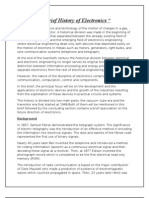0 ratings0% found this document useful (0 votes)
31 viewsASSIGNMENT
ASSIGNMENT
Uploaded by
ALJAN VALERAThe history of electronics began in the late 19th century with the invention of vacuum tubes like the diode and triode, which were used to amplify electrical signals and dominated electronics until World War II. The transistor era began in 1948 with the invention of the junction transistor, followed by the development of integrated circuits in the 1950s-1970s which integrated entire circuits onto a single chip. Major subsequent developments included the microprocessor in 1969 and analog integrated circuits.
Copyright:
© All Rights Reserved
Available Formats
Download as PDF, TXT or read online from Scribd
ASSIGNMENT
ASSIGNMENT
Uploaded by
ALJAN VALERA0 ratings0% found this document useful (0 votes)
31 views5 pagesThe history of electronics began in the late 19th century with the invention of vacuum tubes like the diode and triode, which were used to amplify electrical signals and dominated electronics until World War II. The transistor era began in 1948 with the invention of the junction transistor, followed by the development of integrated circuits in the 1950s-1970s which integrated entire circuits onto a single chip. Major subsequent developments included the microprocessor in 1969 and analog integrated circuits.
Copyright
© © All Rights Reserved
Available Formats
PDF, TXT or read online from Scribd
Share this document
Did you find this document useful?
Is this content inappropriate?
The history of electronics began in the late 19th century with the invention of vacuum tubes like the diode and triode, which were used to amplify electrical signals and dominated electronics until World War II. The transistor era began in 1948 with the invention of the junction transistor, followed by the development of integrated circuits in the 1950s-1970s which integrated entire circuits onto a single chip. Major subsequent developments included the microprocessor in 1969 and analog integrated circuits.
Copyright:
© All Rights Reserved
Available Formats
Download as PDF, TXT or read online from Scribd
Download as pdf or txt
0 ratings0% found this document useful (0 votes)
31 views5 pagesASSIGNMENT
ASSIGNMENT
Uploaded by
ALJAN VALERAThe history of electronics began in the late 19th century with the invention of vacuum tubes like the diode and triode, which were used to amplify electrical signals and dominated electronics until World War II. The transistor era began in 1948 with the invention of the junction transistor, followed by the development of integrated circuits in the 1950s-1970s which integrated entire circuits onto a single chip. Major subsequent developments included the microprocessor in 1969 and analog integrated circuits.
Copyright:
© All Rights Reserved
Available Formats
Download as PDF, TXT or read online from Scribd
Download as pdf or txt
You are on page 1of 5
Overview of the History of Electronics
HISTORY OF ELECTRONICS
AND THEIR DEVELOPMENT
Electronics’ actual history began with the
invention of vacuum diode by J.A. Fleming, in 1897;
and, after that, a vacuum triode was implemented by
Lee De Forest to amplify electrical signals. This led
to the introduction of tetrode and pentode tubes
that dominated the world until World War II.
Subsequently, the transistor
era began with the junction
transistor invention in 1948.
Even though this particular
invention got a Nobel Prize,
yet it was later replaced
with a bulky vacuum tube
that would consume high
power for its operation. The use of germanium and
silicon semiconductor materials made these
transistors gain popularity and wide-acceptance
usage in different electronic circuits.
Overview of the History of Electronics
The subsequent years witnessed
the invention of the integrated
circuits (ICs) that drastically
changed the electronic
circuits’ nature as the entire
electronic circuit got
integrated on a single chip,
which resulted in low: cost, size, and weight
electronic devices. The years 1958 to 1975 marked the
introduction of IC with enlarged capabilities of
over several thousand components on a single chip
such as small-scale integration, medium-large
scale, and very-large-scale integration ICs.
And the trend further carried forward with the
JFETS and MOSFETs that were developed from 1951 to
1958 by improving the device designing process and
by making more reliable and powerful transistors.
Digital integrated circuits were yet another
robust IC development that changed the overall
architecture of computers. These ICs were
developed with Transistor-transistor logic (TTL),
integrated injection logic (I2L), and emitter-
coupled logic (ECL) technologies.
Overview of the History of Electronics
Later these digital ICs employed PMOS, NMOS, and
CMOS fabrication design technologies.
All these radical changes in all these components
led to the introduction of microprocessors in 1969
by Intel. Soon after, the analog integrated
circuits were developed that introduced an
operational amplifier for analog signal processing.
These analog circuits include analog multipliers,
ADC and DAC converters, and analog filters.
Major events in the history of electronics:
1752 – Benjamin Franklin discovered that
lightning is electrical by flying a kite, and
explained how Leyden jars work.
1800 – Alessandro Volta invented battery (Dry
Cell).
1820 – AndrE Marie AmpEre published his law of
electrodynamics called AmpEre’s law.
1826 – Georg Ohm introduced Ohm’s Law.
1831 – Michael Faraday published the law of
induction.
1931 – Michael Faraday invented transformer.
1831 – Joseph Henry developed a prototype DC
motor.
Overview of the History of Electronics
1836 – Nicholas Callan invented transformer.
1844 – Samuel Morse developed telegraphy and
the Morse code.
1856 – Charles Bourseul proposed telephony.
1862 – James Clerk Maxwell published four
equations bearing his name “Maxwell’s
equations“.
1876 – Alexander Graham Bell invented telephone.
1877 – Thomas Alva Edison invented phonograph.
1878 – Joseph Swan invented Incandescent light
bulb.
1879 – Thomas Alva Edison introduced a long
lasting filament for incandescent lamp.
1887 – Nikola Tesla invented the first induction
motor.
1888 – Heinrich Hertz proved that electro
magnetic waves travel over some distance.
1890 – Thomas Alva Edison invented fuse.
1897 – Karl Ferdinand Braun invented cathode
ray oscilloscope (CRO).
1901 – Guglielmo Marconi made first
transatlantic radio broadcast.
1904 – John Ambrose Fleming invented diode.
1906 – Lee de Forest invented triode.
Overview of the History of Electronics
1912 – Edwin Howard Armstrong developed
Electronic oscillator.
1915 – Albert Einstein published the Theory of
Relativity.
1941 – Konrad Zuse developed the first
programmable computer.
1943 – Eisler invented the Printed Circuit
Board.
1958 – Jack Kilby invented the integrated
circuit (IC).
1962 – Nick Holonyak Jr. invented the LED.
1962 – Hofstein, Heiman, and RCA invented
MOSFET Transistors.
1964 – Kemeny and Kurtz introduced the BASIC
programming language.
1970 – INTEL introduced the first
Microprocessor.
1971 – Robert Noyce and Gordon Moore formed
Intel.
You might also like
- Final Result Mumbai 2024 - 0Document13 pagesFinal Result Mumbai 2024 - 0Milan PjNo ratings yet
- Clickbank Affiliate BibleDocument33 pagesClickbank Affiliate Bibletrung nguyen nhatNo ratings yet
- Renryuu Ascension - WalkthroughDocument174 pagesRenryuu Ascension - WalkthroughJuanky HoHNo ratings yet
- A Brief History of Electronics Complete)Document8 pagesA Brief History of Electronics Complete)Maram AhmedNo ratings yet
- Brief History of Industrial ElectronicsDocument3 pagesBrief History of Industrial ElectronicsMary Mae JeremiasNo ratings yet
- Conveyancing Notes 1Document8 pagesConveyancing Notes 1Syarah Syazwan Satury67% (6)
- B737 QRH New Format HandoutDocument15 pagesB737 QRH New Format HandoutDiana Bi100% (5)
- History of Electronics PDFDocument5 pagesHistory of Electronics PDFEj Mar ManabatNo ratings yet
- History of Electronics: TransistorDocument18 pagesHistory of Electronics: TransistorAngelo Zaldy FranciaNo ratings yet
- History of Electronics and Their Generations in BreifDocument14 pagesHistory of Electronics and Their Generations in BreifHarshal VaidyaNo ratings yet
- Electrical Engineering: ReviewDocument30 pagesElectrical Engineering: ReviewpriyaNo ratings yet
- Electronics DefinitionDocument12 pagesElectronics DefinitionSo NnyNo ratings yet
- History of Electricity and ElectronicsDocument4 pagesHistory of Electricity and ElectronicsKorrene ReyesNo ratings yet
- A Brief History of ElectronicsDocument9 pagesA Brief History of ElectronicsImaduddin SharafiNo ratings yet
- Reporting Ee 1Document9 pagesReporting Ee 1josiephilmanzano12No ratings yet
- Reference Notes Introduction To Electrical EngineeringDocument8 pagesReference Notes Introduction To Electrical Engineeringokumuenock000No ratings yet
- Lesson 1 Intro To ElectronicsDocument8 pagesLesson 1 Intro To ElectronicsJas LmsnNo ratings yet
- Table of ContentDocument14 pagesTable of ContentmaderaclairolNo ratings yet
- ElectronicsDocument1 pageElectronicsRexi AbonNo ratings yet
- History of ElectronicsDocument19 pagesHistory of ElectronicsElmarie RecorbaNo ratings yet
- Brief History of ElectronicsDocument2 pagesBrief History of Electronicslady catherine enriquezNo ratings yet
- Semiconductor Devices Notes1Document23 pagesSemiconductor Devices Notes1Sivasai CharithaNo ratings yet
- Electrical Engineering: From Wikipedia, The Free EncyclopediaDocument6 pagesElectrical Engineering: From Wikipedia, The Free EncyclopediaKaran KimianNo ratings yet
- History of ElectronicsDocument1 pageHistory of ElectronicsLynlie Ann EbonNo ratings yet
- CSS 7 DionioDocument5 pagesCSS 7 DionioHeindrielito Benigno RotersosNo ratings yet
- Basic Electronics HistoryDocument2 pagesBasic Electronics HistoryMark JannszenNo ratings yet
- ElectronicsDocument3 pagesElectronicsSherlyn MeranNo ratings yet
- IA 212 - Hand OutsDocument5 pagesIA 212 - Hand Outsfern suenoNo ratings yet
- Brief History of ElectronicsDocument2 pagesBrief History of ElectronicsLaureenMiranda100% (1)
- A Brief History of ElectronicsDocument12 pagesA Brief History of ElectronicsJayvee ColiaoNo ratings yet
- History of GSM - OutputDocument11 pagesHistory of GSM - OutputRaj MohanNo ratings yet
- FALLSEM2023-24 BEEE102L TH VL2023240106701 2023-08-14 Reference-Material-IDocument22 pagesFALLSEM2023-24 BEEE102L TH VL2023240106701 2023-08-14 Reference-Material-Irma46700No ratings yet
- ECE321-1A Assignment #1 06-23-11 Pg1-15Document15 pagesECE321-1A Assignment #1 06-23-11 Pg1-15RischienMarquezNo ratings yet
- PTE - 1.3 - Electrical Engineering and Sub-DiciplinesDocument64 pagesPTE - 1.3 - Electrical Engineering and Sub-DiciplinesKadal AspalNo ratings yet
- Electronics History TimelineDocument2 pagesElectronics History TimelineJON LESTER CABANESNo ratings yet
- Stochastic ProcessDocument17 pagesStochastic ProcessSoloproNo ratings yet
- Info Sheet - No. 1 - ElectronicsDocument23 pagesInfo Sheet - No. 1 - ElectronicsRai ZaNo ratings yet
- OBRADORDocument1 pageOBRADORLeslie Jean ObradorNo ratings yet
- OBRADORLJDocument1 pageOBRADORLJLeslie Jean ObradorNo ratings yet
- TeliphoneDocument109 pagesTeliphonemodismm33100% (1)
- Electricity Has Been A Subject of Scientific Interest Since at Least The EarlyDocument2 pagesElectricity Has Been A Subject of Scientific Interest Since at Least The EarlyShin Darren BasabeNo ratings yet
- ACCE 1 M - L01 IntroductionDocument31 pagesACCE 1 M - L01 IntroductionMike SantosNo ratings yet
- Module 1 Introduction To ElectronicsDocument4 pagesModule 1 Introduction To ElectronicsAldrin VillanuevaNo ratings yet
- Difference Between Transistor and Vacuum TubeDocument5 pagesDifference Between Transistor and Vacuum TubeBib YenNo ratings yet
- Divais MikroelektronikaDocument6 pagesDivais MikroelektronikaFaiza Abu RizalNo ratings yet
- A Brief History of Electronic: From Vacuum Tube To Solid StateDocument12 pagesA Brief History of Electronic: From Vacuum Tube To Solid StateHarkishen SinghNo ratings yet
- Selected Landmarks in ElectronicsDocument8 pagesSelected Landmarks in ElectronicsSatish K. RamojiNo ratings yet
- Electrical EngineeringDocument10 pagesElectrical Engineeringkim jeonNo ratings yet
- Kids History of ElectricityDocument2 pagesKids History of ElectricityrezhabloNo ratings yet
- Eee CH 17Document22 pagesEee CH 17maryjoyce melgarNo ratings yet
- Introduction To Microelectronics: COELEC2: Microelectronics Engr. Alberto C. Cruz JRDocument50 pagesIntroduction To Microelectronics: COELEC2: Microelectronics Engr. Alberto C. Cruz JREunice San MiguelNo ratings yet
- 1.what Is ElectricityDocument46 pages1.what Is ElectricityKATE ARBIE LACDO-ONo ratings yet
- History of ElectricityDocument34 pagesHistory of ElectricityZaigham SultanNo ratings yet
- Electronics History PDFDocument75 pagesElectronics History PDFYi Yi HlaingNo ratings yet
- Electronics: The History of Electronics The Vacuum Tube EraDocument14 pagesElectronics: The History of Electronics The Vacuum Tube EraAliyaNo ratings yet
- Chapter 1 - IntroductionDocument3 pagesChapter 1 - IntroductionErwin Jetro NajitoNo ratings yet
- The History of ElectronicsDocument62 pagesThe History of ElectronicsBananarama GuitarNo ratings yet
- History of MicroelectronicsDocument60 pagesHistory of MicroelectronicsRalph Laurence G VisayaNo ratings yet
- Electromechanical and Electronic Period: Presented by Marwin VillaDocument12 pagesElectromechanical and Electronic Period: Presented by Marwin Villarheena espirituNo ratings yet
- GE 101 EE ReportDocument6 pagesGE 101 EE ReportDevrajNo ratings yet
- Abstraction: How Electronics Devices Begin?Document11 pagesAbstraction: How Electronics Devices Begin?Shane Patrick PanilagNo ratings yet
- Chapter Three Hiostry of Electrical EngineeringDocument41 pagesChapter Three Hiostry of Electrical EngineeringdanielbirbirsaNo ratings yet
- 17Document4 pages17miej1173No ratings yet
- From Sparks to Silicon: The Revolutionary Journey of Electronics and ComputingFrom EverandFrom Sparks to Silicon: The Revolutionary Journey of Electronics and ComputingNo ratings yet
- Indigenous Therapies - Sleep and WorkDocument13 pagesIndigenous Therapies - Sleep and WorkRaabiyaNo ratings yet
- Sap AbapDocument9 pagesSap Abapneetika998No ratings yet
- Karnataka Forest DepartmentDocument1 pageKarnataka Forest DepartmentVinayaka GombiNo ratings yet
- INGLÉS - 4° Año - 2da EntregaDocument13 pagesINGLÉS - 4° Año - 2da EntregaCintiaNo ratings yet
- 1 Curriculum Vitae - Indra GunawanDocument2 pages1 Curriculum Vitae - Indra GunawankuntulllNo ratings yet
- Cda10 Eng Rev01 (001-089)Document89 pagesCda10 Eng Rev01 (001-089)David MotiñoNo ratings yet
- Assignment 2Document7 pagesAssignment 2ue06037No ratings yet
- 5 3 3 2 + + - Where K Is An Integer To Be Found. (3) : 1 Without Using A Calculator, Show ThatDocument13 pages5 3 3 2 + + - Where K Is An Integer To Be Found. (3) : 1 Without Using A Calculator, Show ThatNirvaan PuriNo ratings yet
- CO2 Session 9Document40 pagesCO2 Session 9Sripada khowshikk sharmaNo ratings yet
- Battery Inverter: 5 KVA: Lot 1 Boq (Amran)Document2 pagesBattery Inverter: 5 KVA: Lot 1 Boq (Amran)MOHAMMED. HAKAMINo ratings yet
- Role of Government in Corporate GovernanceDocument2 pagesRole of Government in Corporate GovernanceIshanDograNo ratings yet
- CBCL - 6 18 - 201 Sample Copy Watermark 1Document4 pagesCBCL - 6 18 - 201 Sample Copy Watermark 1Meritxell PerezNo ratings yet
- Elsiver Paper #2 PDFDocument9 pagesElsiver Paper #2 PDFSiva NarayanaNo ratings yet
- Module 2 - Infectious ProcessDocument3 pagesModule 2 - Infectious ProcessRashid DayaoNo ratings yet
- Assignment: MA (History) Semester-IiDocument4 pagesAssignment: MA (History) Semester-IiMinhaz AlamNo ratings yet
- Report On UfoneDocument65 pagesReport On UfoneUmair AminNo ratings yet
- Call For StudentDocument166 pagesCall For StudentBoris DossaNo ratings yet
- Task 6 Analyzing Generic Structure of SongDocument3 pagesTask 6 Analyzing Generic Structure of SongAhmad Satria100% (1)
- k48 - Anh 2 CLCTCNH - Le Anh MinhDocument72 pagesk48 - Anh 2 CLCTCNH - Le Anh MinhMinh Anh0% (1)
- Arts 1Document13 pagesArts 1Lance David TanNo ratings yet
- Ooad NotesDocument92 pagesOoad NotesSenthil IlangovanNo ratings yet
- Clay Minerals and Engineering New (1) - Read-Only-1Document28 pagesClay Minerals and Engineering New (1) - Read-Only-1Lebohang SheaneNo ratings yet
- OM PA and Payroll Stepwise ConfigurationsDocument11 pagesOM PA and Payroll Stepwise Configurationsnalini saxenaNo ratings yet
- Wall Thickness CalculationDocument8 pagesWall Thickness CalculationbektiNo ratings yet
- Product Sheet Petlin LD C150y - 0Document2 pagesProduct Sheet Petlin LD C150y - 0121221042No ratings yet

























































































